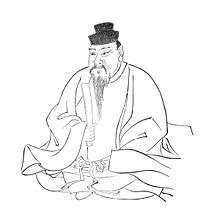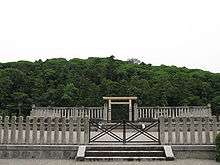Emperor Ōjin
| Ōjin | |
|---|---|
| Emperor of Japan | |
 Emperor Ōjin | |
| Reign | 270–310 (traditional)[1] |
| Predecessor | Chūai |
| Successor | Nintoku |
| Born |
200 Umi (Fukuoka) |
| Died |
310 (aged 110) Karushima no Toyoakira (Nara) |
| Burial | Eega no Mofushi no oka no misasagi (Osaka) |
| Spouse | Nakatsuhime |
| House | Yamato dynasty |
| Father | Emperor Chūai |
| Mother | Empress Jingū |
Emperor Ōjin (応神天皇 Ōjin-tennō), also known as Homutawake or Hondawake (誉田別), was the 15th emperor of Japan,[2] according to the traditional order of succession.[3]
No firm dates can be assigned to this emperor's life or reign, but he is conventionally considered to have reigned from 270 to 310.[4]
Legendary narrative
Ōjin is regarded by historians as a "legendary emperor" of the 5th century.[5] The reign of Emperor Kinmei (c. 509 – 571 AD), the 29th emperor,[6] is the first for which contemporary historiography is able to assign verifiable dates;[7] however, the conventionally accepted names and dates of the early emperors were not to be confirmed as "traditional" until the reign of Emperor Kanmu (737–806), the 50th sovereign of the Yamato dynasty.[8]
The name Ōjin Tennō was assigned to him posthumously by later generations. Ōjin is also identified by some as the earliest "historical" emperor.[9]
According to the Kojiki and the Nihonshoki, Ōjin was the son of the Emperor Chūai and his consort Jingū. As Chūai died before Ōjin's birth, his mother Jingū became the de facto ruler. The history book written to the 8th century, alleged that the boy Ōjin was conceived but unborn when Chūai died. His widow, Jingū, then spent three years in conquest of a promised land, which is conjectured to be Korea, but the story is largely dismissed by scholars for lack of evidence. Then, after her return to Japanese islands, the boy was born, three years after the death of the father.
Either a period of less than nine months contained three "years" (some seasons), e.g. three harvests, or the paternity is just mythical and symbolic, rather than real. Ōjin was born (in 200 according to the traditional, but untrustworthy TC date, timetable; realistically sometime in the late 4th century) in Tsukushi on the return of his mother from the invasion of the promised land and named him Prince Hondawake. He became the crown prince at the age of four. He was crowned (in 270) at the age of 70 and reigned for 40 years until his death in 310, although none of the TC dates around his reign have any historical basis. He supposedly lived in two palaces both of which are in present-day Osaka.
Ōjin was traditionally identified as the father of Emperor Nintoku, who acceded after Ōjin's death.[10] Ōjin has been deified as Hachiman Daimyōjin, regarded as the guardian of warriors. The Hata Clan considered him their guardian Kami.

The actual site of Ōjin's grave is not known.[2] This emperor is traditionally venerated at a memorial Shinto shrine (misasagi) at Osaka.
The Imperial Household Agency designates this location as Ōjin's mausoleum. It is formally named Eega no Mofushi no oka no misasagi.[11]
Consorts and children
Empress: Nakatsuhime (仲姫命), daughter of Homudamawaka (品陀真若王)
- Princess Arata (荒田皇女)
- Prince Ōosazaki (大鷦鷯尊) Emperor Nintoku
- Prince Netori (根鳥皇子), ancestor of Ōta no Kimi (大田君)
Takakiirihime (高城入姫命), older sister of Nakatsuhime
- Prince Nukata no Ōnakatsuhiko (額田大中彦皇子)
- Prince Ōyamamori (大山守皇子), ancestor of Hijikata no Kimi (土形君) and Haibara no Kimi(榛原君)
- Prince Izanomawaka (去来真稚皇子), ancestor of Fukakawawake (深河別)
- Princess Ōhara (大原皇女)
- Princess Komukuta (澇来田皇女)
Otohime (弟姫命), younger sister of Nakatsuhime
- Princess Ahe (阿倍皇女)
- Princess Awaji no Mihara (淡路御原皇女), wife of Netori
- Princess Ki no Uno (紀之菟野皇女)
- Princess Shigehara (滋原皇女)
- Princess Mino no Iratsume (三野郎女)
Miyanushiyakahime (宮主宅媛), daughter of Wani no Hifure no Omi (和弭日触使主)
- Prince Uji no Wakiiratsuko (菟道稚郎子皇子), Crown Prince
- Princess Yata (矢田皇女), wife of Emperor Nintoku
- Princess Metori (雌鳥皇女)
Onabehime (小甂媛), younger sister of Miyanushiyakahime
- Princess Uji no Wakiiratsuhime (菟道稚郎女皇女), wife of Emperor Nintoku
Okinaga mawakanakatsuhime (息長真若中比売), daughter of Kawamatanakatsuhiko (河派仲彦)
- Prince Wakanuke no futamata (稚野毛二派皇子), ancestor of Okinaga clan (息長君). great-grandfather of Emperor Keitai
Itohime (糸媛), daughter of Sakuraitabe no Muraji Shimatarine (桜井田部連島垂根)
- Prince Hayabusawake (隼総別皇子)
Himuka no Izumi no nagahime (日向泉長媛)
- Prince Ōhae (大葉枝皇子)
- Prince ohae (小葉枝皇子)
- Princess Hatabi no Wakairatsume (幡日之若郎女), wife of Emperor Richū
Kagurohime (迦具漏比売), daughter of Sumeiro Ōnakahiko (須売伊呂大中日子王女)
- Princess Kawarata no iratsume (川原田郎女)
- Princess Tama no iratsume (玉郎女)
- Prince Kataji (迦多遅王)
Katsuragi no Irome (葛城野伊呂売), daughter of Takenouchi no Sukune ?
- Prince Izanomawaka ? (伊奢能麻和迦王)
Ehime (兄媛), younger sister of Kibi no Mimotowake (吉備御友別)
See also
| Wikimedia Commons has media related to Emperor Ōjin. |
Notes

- ↑ "Genealogy of the Emperors of Japan" at Kunaicho.go.jp; retrieved 2013-8-28.
- 1 2 Imperial Household Agency (Kunaichō): 応神天皇 (15); retrieved 2013-8-26.
- ↑ Titsingh, Isaac. (1834). Annales des empereurs du japon, pp. 19–22; Brown, Delmer M. (1979). Gukanshō, p. 255–256; Varley, Paul. (1980). Jinnō Shōtōki, pp. 103–110.
- ↑ Ponsonby-Fane, Richard. (1959). The Imperial House of Japan, p. 36.
- ↑ Kelly, Charles F. "Kofun Culture," Japanese Archaeology. 27 April 2009.
- ↑ Titsingh, pp. 34–36; Brown, pp. 261–262; Varley, pp. 123–124.
- ↑ Hoye, Timothy. (1999). Japanese Politics: Fixed and Floating Worlds, p. 78; excerpt, "According to legend, the first Japanese emperor was Jinmu. Along with the next 13 emperors, Jinmu is not considered an actual, historical figure. Historically verifiable Emperors of Japan date from the early sixth century with Kinmei.
- ↑ Aston, William. (1896). Nihongi, pp. 109.
- ↑ Wakabayashi, Tadashi. (1995) Japanese loyalism reconstrued, p. 108., p. 108, at Google Books
- ↑ Aston, William George. (1998). Nihongi, p. 254–271.
- ↑ Ponsonby-Fane, p. 419.
References
- Aston, William George. (1896). Nihongi: Chronicles of Japan from the Earliest Times to A.D. 697. London: Kegan Paul, Trench, Trubner. OCLC 448337491
- Brown, Delmer M. and Ichirō Ishida, eds. (1979). Gukanshō: The Future and the Past. Berkeley: University of California Press. ISBN 978-0-520-03460-0; OCLC 251325323
- Chamberlain, Basil Hall. (1920). The Kojiki. Read before the Asiatic Society of Japan on April 12, May 10, and June 21, 1882; reprinted, May 1919. OCLC 1882339
- Ponsonby-Fane, Richard Arthur Brabazon. (1959). The Imperial House of Japan. Kyoto: Ponsonby Memorial Society. OCLC 194887
- Titsingh, Isaac. (1834). Nihon Ōdai Ichiran; ou, Annales des empereurs du Japon. Paris: Royal Asiatic Society, Oriental Translation Fund of Great Britain and Ireland. OCLC 5850691
- Varley, H. Paul. (1980). Jinnō Shōtōki: A Chronicle of Gods and Sovereigns. New York: Columbia University Press. ISBN 978-0-231-04940-5; OCLC 59145842
- Wakabayashi, Tadashi. (1995). Japanese loyalism reconstrued: Yamagata Daini's Ryūshi shinron of 1759. Honolulu: University of Hawaii Press. ISBN 9780824816674; OCLC 31078696
| Regnal titles | ||
|---|---|---|
| Preceded by Emperor Chūai |
Emperor of Japan: Ōjin 270–310 (traditional dates) |
Succeeded by Emperor Nintoku |
